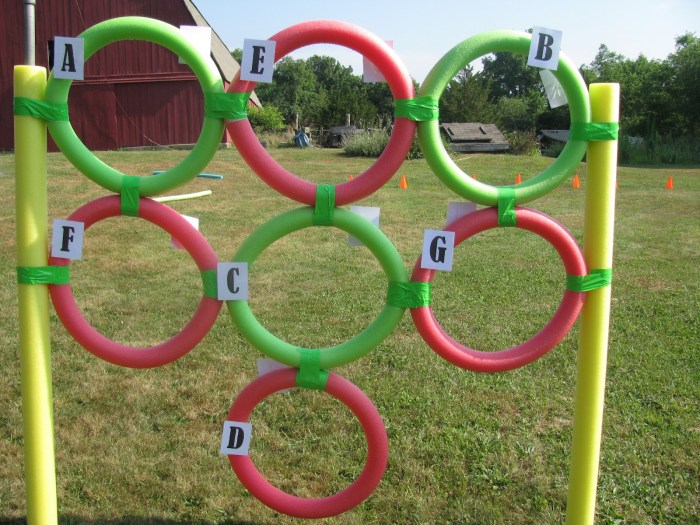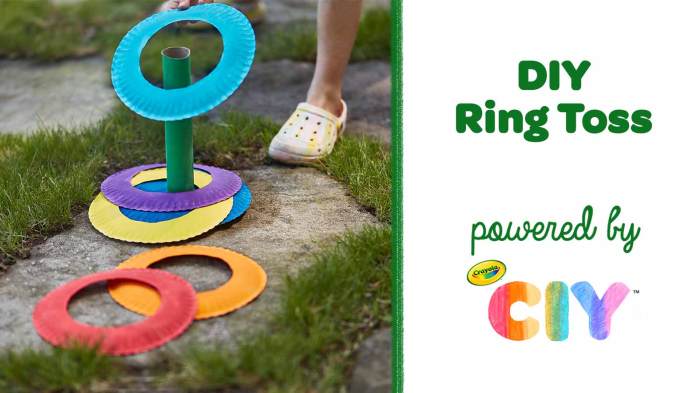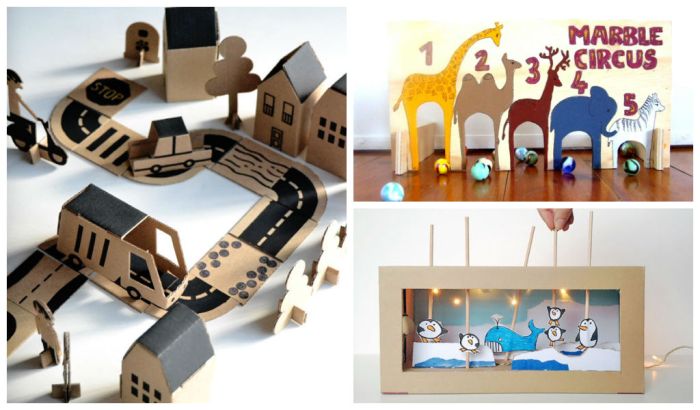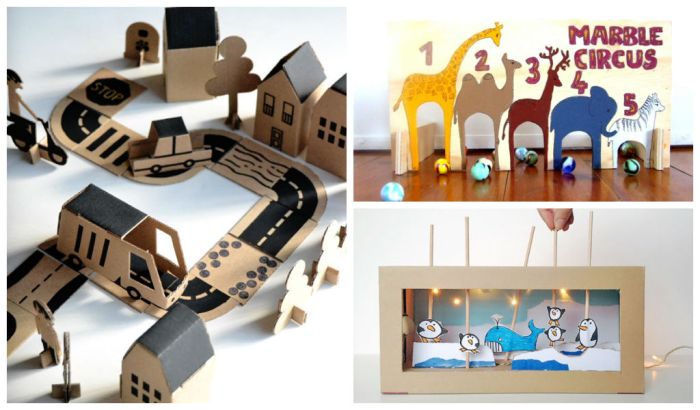DIY games for kids are a fantastic way to ignite creativity, encourage learning, and foster a love for play. They offer a hands-on approach to education, allowing children to explore their interests and develop essential skills through engaging activities.
From sensory exploration and fine motor skill development to cognitive challenges and social interaction, these DIY games cater to a wide range of developmental needs. The beauty of DIY games lies in their adaptability. You can tailor them to suit different age groups, interests, and learning styles, making them a versatile tool for parents, educators, and caregivers.
Introduction to DIY Games for Kids

DIY games offer a unique opportunity for children to engage in creative play, fostering their imagination, problem-solving skills, and overall development. By encouraging kids to build their own games, we empower them to explore their ideas, experiment with different materials, and learn through hands-on experiences.
Benefits of DIY Games for Children’s Development
Engaging in DIY games can provide numerous benefits for children’s development. These activities can enhance their cognitive skills, boost their creativity, and foster a love for learning.
- Cognitive Skills: DIY games encourage children to think critically, solve problems, and develop strategic thinking skills. They learn to analyze situations, plan their actions, and adapt to changing circumstances. For example, building a board game involves planning the game board layout, designing game pieces, and developing rules, all of which stimulate cognitive development.
- Creativity: DIY games allow children to express their creativity through various mediums. They can design their own game concepts, create unique characters and settings, and experiment with different materials. This freedom of expression helps them develop their imagination and explore their artistic talents.
- Social Skills: DIY games can be a great way for children to learn about teamwork, communication, and negotiation. They can work together to design and build their games, learn to compromise, and respect different perspectives.
- Fine Motor Skills: Building DIY games involves using their hands and fingers to manipulate materials, which helps to improve their fine motor skills. This is especially beneficial for younger children who are still developing these skills. For example, cutting, gluing, and painting game pieces all require precise hand movements.
- Problem-Solving Skills: DIY games often involve troubleshooting and overcoming challenges. When faced with a problem, children learn to think creatively, find solutions, and adapt their strategies. This process helps them develop their problem-solving abilities, which are essential for success in all areas of life.
Engaging Children in Creative Play
Encouraging children to engage in creative play is crucial for their development. It allows them to explore their imagination, express themselves freely, and learn through hands-on experiences.
- Provide a Variety of Materials: Offer a diverse range of materials, such as cardboard boxes, construction paper, markers, paints, beads, buttons, and fabric scraps. This allows children to experiment with different textures, colors, and shapes, fostering their creativity.
- Encourage Exploration: Encourage children to explore different ideas and experiment with various materials. Don’t be afraid to let them make mistakes; it’s through trial and error that they learn and grow.
- Offer Open-Ended Activities: Provide open-ended activities that allow children to use their imaginations and create their own games and stories. For example, a simple cardboard box can be transformed into a spaceship, a castle, or a pirate ship, depending on their imagination.
- Collaborate with Children: Get involved in the process and collaborate with children on their DIY game projects. Ask them questions, offer suggestions, and provide support as needed. This shows them that you value their creativity and are invested in their learning journey.
Choosing Age-Appropriate DIY Games
When choosing DIY games for children, it’s essential to consider their age and developmental stage. Selecting age-appropriate projects ensures that children are challenged but not overwhelmed.
- Simple Games for Younger Children: For younger children, focus on simple games that involve basic skills, such as matching, sorting, or counting. Examples include:
- Matching Game: Create cards with pictures of matching objects, such as animals, colors, or shapes. Children can match the cards together, developing their visual recognition and memory skills.
- Sorting Game: Use objects of different colors, sizes, or shapes and have children sort them into categories. This helps them develop their classification skills and learn about patterns.
- Counting Game: Create a game board with numbered spaces and have children roll a die and move their game piece according to the number rolled. This helps them learn about numbers and counting.
- More Complex Games for Older Children: Older children can handle more complex games that involve strategy, problem-solving, and creativity. Examples include:
- Board Games: Encourage older children to design their own board games, incorporating themes, rules, and challenges that interest them. This helps them develop their creativity, strategic thinking, and problem-solving skills.
- Card Games: Create custom card games with unique rules and objectives. This allows children to explore different game mechanics and develop their decision-making skills.
- Role-Playing Games: Encourage older children to create their own role-playing games, where they can assume different roles and engage in imaginative storytelling. This helps them develop their social skills, communication, and creativity.
DIY Games for Cognitive Development

DIY games can be a fun and engaging way to help children develop their cognitive skills. These games encourage critical thinking, problem-solving, memory, and attention, all while keeping kids entertained.
DIY Memory Game
A memory game is a classic way to improve memory and concentration. Here’s how to create a DIY memory game using picture cards or objects:
- Choose a theme: Select a theme that interests your child, such as animals, fruits, vehicles, or letters. You can even use family photos for a personalized touch.
- Gather materials: You’ll need two sets of identical images or objects. You can use index cards, construction paper, or even old magazines. If using objects, ensure they are small enough to be easily handled.
- Create the cards: Cut out the images or objects and glue them onto the cards or objects. Make sure the images are clear and easily recognizable.
- Play the game: Spread out the cards face down on a table. Players take turns flipping over two cards at a time, trying to find a match. If they find a match, they keep the cards. If not, they flip them back over. The player with the most matches at the end wins.
To make the game more challenging, increase the number of cards or introduce a timer.
DIY Sorting Game
Sorting games help children develop their categorization skills and understanding of patterns. Here’s how to create a DIY sorting game:
- Choose a sorting criteria: You can sort objects by color, shape, size, or even texture. For example, you could use different colored buttons, wooden blocks of various shapes, or a collection of toys.
- Gather materials: Collect a variety of objects that fit your chosen sorting criteria. You can use household items, toys, or even natural materials like leaves, stones, or shells.
- Prepare the sorting areas: Use containers, bowls, or trays to create separate areas for each category. Label each area clearly with the sorting criteria.
- Play the game: Have your child sort the objects into the appropriate containers based on the chosen criteria. You can make the game more challenging by adding more categories or introducing new objects.
This game can be adapted to different age groups and learning levels.
DIY Board Game
Creating a simple board game encourages children to develop strategic thinking, problem-solving skills, and understanding of rules. Here’s how to create a DIY board game:
- Design the game board: Draw or print a simple board with squares or spaces. You can use graph paper or a large sheet of paper. Get creative with the design and theme.
- Create game pieces: Use buttons, small toys, or even cut-out shapes as game pieces. Make sure you have enough for all players.
- Determine the game rules: Decide on the objective of the game, how players move their pieces, and what actions they can take. You can incorporate dice, cards, or spinners to add variation and challenge.
- Add extra elements: To make the game more engaging, you can include special squares, obstacles, or rewards. You can also create cards with different actions or challenges.
Remember to keep the rules simple and easy to understand, especially for younger children. Encourage them to participate in designing the game and coming up with their own ideas.
DIY Games for Learning Letters and Numbers
Playing games is an enjoyable way for kids to learn and develop essential skills. DIY games, in particular, offer a hands-on experience that can be tailored to the child’s individual learning style and pace. Here are some ideas for creating DIY games that help children learn letters and numbers.
Organizing a DIY Alphabet Game Using Colorful Blocks or Flashcards
Flashcards or colorful blocks are excellent tools for introducing letters to young children. They provide visual cues and a tactile experience that can help them remember the letter shapes.
To create an alphabet game using blocks or flashcards, you can:
- Write the letters of the alphabet on the blocks or flashcards. Use different colors for each letter to make it more visually appealing.
- Play a matching game. Lay out the blocks or flashcards face down and have the child turn over two at a time to find matching letters.
- Play a memory game. Lay out a few blocks or flashcards face up, give the child a few seconds to memorize them, then turn them face down. Have the child try to find the matching pairs.
- Play a sorting game. Have the child sort the blocks or flashcards by letter, such as all the vowels together or all the consonants together.
Creating a Number Matching Game Using Household Items
A number matching game can help children learn to recognize numbers and develop their counting skills. You can use common household items like buttons, socks, or even pieces of fruit to create this game.
To create a number matching game, you can:
- Write numbers on the items. For example, you could write the numbers 1 through 10 on buttons or socks.
- Create matching sets. For each number, you will need two items with that number written on them.
- Play a matching game. Lay out the items face down and have the child turn over two at a time to find matching numbers.
Designing a DIY Game Using Dice and Number Cards for Practicing Counting Skills
Dice and number cards are versatile tools that can be used to create a variety of games for practicing counting skills. You can use them to play simple games like “roll and count” or more complex games like “number war.”
To create a dice and number card game, you can:
- Create number cards. You can write numbers on index cards or use commercially available number cards.
- Play “roll and count.” Roll a die and have the child count the dots. Then, have the child find the matching number card.
- Play “number war.” Each player rolls a die and the player with the highest number wins.
DIY Games for Music and Movement

Music and movement are essential components of child development, fostering creativity, coordination, and social skills. DIY games offer a fun and engaging way to incorporate music and movement into playtime.
Creating a DIY Musical Instrument
Creating a DIY musical instrument is a fun and engaging activity that encourages children to explore sound and rhythm.
Here’s how to build a simple instrument using recycled materials:
- Materials: Empty tin cans, rubber bands of varying sizes, scissors, tape, and a marker.
- Instructions:
- Clean and dry the empty tin cans. Use the marker to decorate the cans with patterns or colors.
- Cut the rubber bands to different lengths, ensuring they are long enough to wrap around the can.
- Wrap the rubber bands around the can, securing them with tape. Experiment with different combinations of rubber band sizes and placements to create different sounds.
- Encourage children to explore the instrument by plucking the rubber bands to create various notes and rhythms.
Creating a Dance Game
Dance games provide a fun and engaging way to encourage physical activity and creativity.
Here are some simple steps to create a dance game:
- Music: Select upbeat music with a clear rhythm. Choose music that children enjoy and can easily move to.
- Movements: Choose a few simple dance moves, such as jumping, twirling, or clapping. You can also incorporate animal movements like hopping like a frog or flapping like a bird.
- Game Structure:
- Explain the dance moves to the children. You can demonstrate the moves or use visual aids like pictures or videos.
- Start the music and have the children follow the dance moves. You can introduce new moves as the game progresses.
- To add a challenge, introduce a freeze dance element. When the music stops, children freeze in their dance pose. The last child to freeze is out.
Building a Simple Drum
Building a simple drum using cardboard and balloons is a fun and easy project that allows children to explore rhythm and sound.
- Materials: Cardboard box, balloon, scissors, tape, and a marker.
- Instructions:
- Cut a circular piece of cardboard from the box, ensuring it is large enough to fit the balloon.
- Cut the top of the balloon and discard it. Stretch the balloon over the cardboard circle, securing it with tape.
- Use the marker to decorate the drum. Encourage children to experiment with different materials to create different sounds, such as tapping on the drum with their hands, wooden spoons, or other household items.
Safety Considerations for DIY Games
Creating DIY games for kids is a fun and engaging activity, but it’s crucial to prioritize safety to ensure a positive experience. By using non-toxic materials and supervising children while they play, you can create a safe and enjoyable environment for them.
Using Non-Toxic Materials
It’s essential to choose non-toxic materials for children’s games, especially when they’re young and prone to putting things in their mouths.
- Opt for paints, markers, and glues labeled as non-toxic and specifically designed for children.
- Avoid using materials that contain lead, phthalates, or other harmful chemicals.
- Natural materials like wood, cardboard, fabric, and paper are generally safe choices.
- If you’re unsure about the safety of a material, consult the manufacturer’s instructions or research online resources.
Supervising Children
Always supervise children while they play with DIY games, especially those involving small parts or sharp objects.
- Be present to ensure they don’t put anything in their mouths or eyes.
- Monitor their use of tools, like scissors or glue guns, to prevent accidents.
- Teach them about safety rules, like not running with scissors or playing near stairs.
Storing and Cleaning Up, Diy games for kids
Proper storage and cleanup are crucial for maintaining a safe and organized play environment.
- Store DIY game materials in designated containers or boxes to prevent them from getting lost or damaged.
- Label containers clearly to identify their contents.
- Clean up any spills or messes promptly to avoid accidents or injuries.
- Involve children in the cleanup process to teach them about responsibility and tidiness.
With a little imagination and some everyday materials, you can create a world of learning and fun for your kids. DIY games offer a unique opportunity to connect with your children, encourage their curiosity, and foster a love for exploration and discovery. So, gather your supplies, unleash your creativity, and embark on a journey of play and learning with DIY games for kids!
DIY games for kids are a fantastic way to encourage creativity and learning. While you’re busy crafting a cardboard castle or painting a giant board game, remember that even seemingly harmless activities can have unexpected consequences. For example, if you’re considering using certain materials, it’s always a good idea to research potential side effects, like you might do with a medication like metformin.
Metformin side effects can include digestive issues and vitamin deficiencies, so it’s important to be aware of them. Just as with medication, always choose materials that are safe and appropriate for children’s play.

